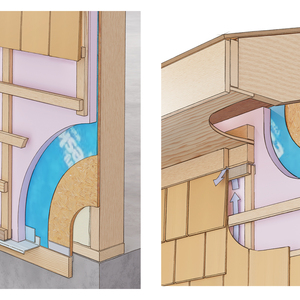Any electricians out there that can help?
Wrapping up a kitchen remodel. From a brand new sub panel we ran 10/3 wire (30 amp breaker) to oven/microwave combo unit. Tried installing the new unit and the breaker kept tripping. Eliminated the unit from the circuit and the breaker remained on. Used a volt meter at the ends of the ciruit and it tested good.
With the unit wired back to the circuit again, we tried once more (this time with the cover plate removed). After throwing the breaker we noticed the ground wire sparking as it was resting against the metal box, and again the breaker tripped. Again, we eliminated the unit from the circuit (making sure that the ground wire was still touching metal) and threw the breaker – this time it did not trip.
Am I wrong to assume that this is evidence of a short in the appliance itself, and we should call the manufacturer?
Thanks for your help.



















Replies
Discounting the microwave why would the "ground wire (be) sparking as it was resting against the metal box"?
The box itself should be connected to the ground wire coming from the panel. Best if done by a dedicated ground screw but a ground clip or grounding contact on a device yoke are legal. Seeing as that the box is maintained at the same potential by the ground wire there should be no way a ground wire on the circuit end could arc to it.
If the ground wire associated with this circuit was not connected to the box why would the ground wire arc to it?
I would check to make sure that the metal box is not contacting something live within or outside the microwave circuit. If you tightened the clamp of an ungrounded metal box too tight you may have cut into the cable and energized the box. Which could arc to ground.
Also if you damaged an existing cable in the wall installing the metal box it could go the same way. A gas, water or refrigerant line, energized by a fault within that system or acting as ground might be a possibility as would heat or exhaust ductwork. Rare but not unheard of. I have seen a few in each category.
A faulty microwave is a possibility but as I see it there is a high probability there is something strange about your side of the installation.
Think hard about calling an electrician. Hard to diagnose over a web connection.
4Lorn1,You wrote:"If you tightened the clamp of an ungrounded metal box too tight you may have cut into the cable and energized the box. Which could arc to ground."I'll have to check this out. However, if I may ask, why would there be arcing ONLY with the appliance connected to the circuit, but not without?Thanks.
IMHO it sounds like you have an electrical problem outside any issues with the appliance. That is not the same as the unit not having a problem.A metal box lacking any electrical connections should never cause arcing if any one wire comes into contact. Electricity wants to go home and flow in loops to AND from the source. This why some repairs of high voltage lines is done from helicopters. The workers and helicopter remains safe as long as there is path in but none out.Ultimately I think your going to have to figure this discrepancy out. By logic, guess or rework and dumb luck. Bad news is that both the circuit and the unit may be defective.On the other hand it shouldn't be too difficult to find out if the microwave unit is faulty. No big problem. Grab a spare 5' length of the cable you used. Clear the jacket, strip the ends and hook it directly into the circuit breaker in the panel. CB off of course. Setting the oven on the ground beside the panel, on a box or sawhorse makes it easier to work on. Don't drop it moving it otherwise the hunt is a self-fulfilling prophecy. Hook up the unit in the normal, manufacturers recommended, manner. See if it runs. Remember to insert something in the unit before running the microwave. A cup of coffee works well and you end up with a piping hot cup of coffee. A reward for your extra work.On the down side if the unit works you now know the problems are in the circuit you ran. So your going to need that coffee.
4Lorn1,
As much as I wanted to believe this problem existed with the appliance, the problem was caused by a small puncture to the red wire at the romex connector. After trying everthing else, I was forced to start cutting away drywall from around the outlet box. Immediately upon removing a small piece, I saw a bit of burnt insulation. Closer inspection revealed that the romex clamp had been installed way too tight and slightly punctured through both the 3 wire sheathing and the sheathing around the red wire. I dropped the outlet box a few inches further down in the wall (to get past the damaged section of wire), perfomed a quick drywall patch w/some hot mud and we were back in business. All is well, and my client can start cooking her Christmas cookies now.Thanks for everyone's input on this. This "breaktime" board is awesome!
Glad it worked out for you. Had an idea it might have some thing to do with a box clamp or connector. A common issue easy to create if the installer leans a bit too heavily on the screwdriver. Such clamps should be just 'snugged up'. As a note for general consumption three-wire cables are particularly prone to over tightening of connectors or clamps. Simply because their spiral construction has the wires crossing which can easily cause the harder wires to pinch through the softer insulation. Either between conductors or with anything exterior applying pressure. Any pressure being concentrated in a very small area. Two-wire cables, where all the conductors run parallel are much less prone to such damage simply because any pressure is spread along the length of two or more cylindrical shaped conductors.Any potential circuit faults in a three wire cable should focus attention at any point where the cable is pinched. Over tightened clamps, connectors and over driven staples being prime points for faults.
Thanks, that's all good information to know!
My guess is you have a hot wire hooked up to the neutral. Was this wired with 10/3 WITH ground?
If it was, and you have a hot wire hooked up where the neutral should be, that would provide a direct path to ground and would explain the sparks and tripped breaker.
Is that really a problem in this country? Men not paying enough attention to women's breasts? - Jay Leno
BossHog,
It is 10/3 wire. The hot and neutral are not switched.
Follow the lead 4lorn posted, i.e. get thyself an electrician..first tho'..kill the breaker. Other wise have a helper with a phone and have that person dial 91..and wait for the other 1 when you see the smoke.
I don't mean to be an alarmist, but as noted, diagnosing a problem over the web is not always the best route for a long and healthy life.
I quadruple checked a circut ( with the help of a REAL electrician) and we found a buried J box, that kept a constant feed, by passing thru a pigtail that was circumventing a breaker that was supposed to be off..ya just never know what is going on, when ya can't see ele.
Go safe mode..it always feels good that way.
Have you yet ?.........
Completely removed the power source (source wiring) from the appliance's junction box.......... then used your meter to run a continuity check between the appliance's hot lead(s) to the chasis of the appliance. If there's continuity ..... there's almost certainly a short somewhere inside the appliance itself.
goldhiller,
thanks for that suggestion - will check that one too. I can rule out any "burried/hidden" j-boxes or other surprises as I ran the 10/3 (with ground) from the sub panel to the appliance cabinet myself. As I stated earlier, I did confirm the proper voltage from panel to outlet box.
Sounds to me like you have neutral and hot reversed somewhere, and there's a bonding strap between ground and neutral in the unit.
happy?
I'm not trying to give you a hard time, but often these problems come down to getting enough detail out there to diagnose. When you say you used a meter and "it tested good", can we assume you mean you measured 240 volts from black to red, 120 volts from black to neutral, 120 volts from red to neutral, 120 volts from red to ground, and 120 volts from black to ground ?
r,
Yes, when I said that I tested with a volt meter and received good readings, I did mean 240 btwn black & red, 120 btwn red & white, etc. etc. I spoke with an electrician buddy of mine by phone and explained the situation to him as well, and he has also advised me to check the continuity between the unit's hot lead(s) and the unit's chasis. I have a real strong suspicion that this is the problem. I appreciate everyones thoughts. I will post back again tomorrow with results.Thanks again!
Don't be surprised it the applaince has a defect. We just installed a $7000 Viking range and the breaker tripped as soon as turned on. It appears they test with the back panel off and then trapped/ cut when they installed it. Just take a test meter and check for shorts between the appliance wires to ground.